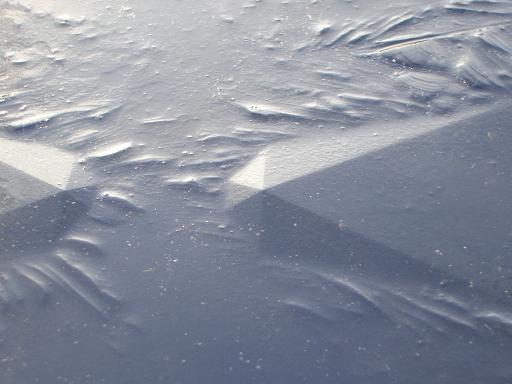Here is a photograph (untouched, not CGI). When I saw it I went wow! (I knew what it was). I’d be interested to know if anyone (a) KNOWS what it is of (b) can estimate the scale (c) has seen anything like it. If you do know, please post a comment saying so [but please DON’T give the answer]. I plan to release more information daily…
Besides the photo itself there is a serious question. How can you search the web for images like this?

and a close-up:

[UPDATE – more info: The photograph was taken yesterday by Dr. Judith Murray-Rust.]
[ANSWER: This is, indeed, crystalline water but the scale took us by surprise. The x-axis is ca. 20 cm. This artefact appeared in our bird bath and there appear to be 2 perfect, huge, hexagonal ice crystals (it is possible that they are both sixfold twins, I suppose). The faces are highly planar and specular (we have more pictures).
It is also remarkable that there are two artefacts separated by 10 cm(between centres) which are almost identical. What possible coupling could there be between them – that is the real mysetery.]
Happy Holliday – as I might say to Gemma.
-
Recent Posts
-
Recent Comments
- pm286 on ContentMine at IFLA2017: The future of Libraries and Scholarly Communications
- Hiperterminal on ContentMine at IFLA2017: The future of Libraries and Scholarly Communications
- Next steps for Text & Data Mining | Unlocking Research on Text and Data Mining: Overview
- Publishers prioritize “self-plagiarism” detection over allowing new discoveries | Alex Holcombe's blog on Text and Data Mining: Overview
- Kytriya on Let’s get rid of CC-NC and CC-ND NOW! It really matters
-
Archives
- June 2018
- April 2018
- September 2017
- August 2017
- July 2017
- November 2016
- July 2016
- May 2016
- April 2016
- December 2015
- November 2015
- September 2015
- May 2015
- April 2015
- January 2015
- December 2014
- November 2014
- September 2014
- August 2014
- July 2014
- June 2014
- May 2014
- April 2014
- March 2014
- February 2014
- January 2014
- December 2013
- November 2013
- October 2013
- September 2013
- August 2013
- July 2013
- May 2013
- April 2013
- March 2013
- February 2013
- January 2013
- December 2012
- November 2012
- October 2012
- September 2012
- August 2012
- July 2012
- June 2012
- May 2012
- April 2012
- March 2012
- February 2012
- January 2012
- December 2011
- November 2011
- October 2011
- September 2011
- August 2011
- July 2011
- May 2011
- April 2011
- March 2011
- February 2011
- January 2011
- December 2010
- November 2010
- October 2010
- September 2010
- August 2010
- July 2010
- June 2010
- May 2010
- April 2010
- August 2009
- July 2009
- June 2009
- May 2009
- April 2009
- March 2009
- August 2008
- July 2008
- June 2008
- May 2008
- April 2008
- March 2008
- February 2008
- January 2008
- December 2007
- November 2007
- October 2007
- September 2007
- August 2007
- July 2007
- June 2007
- May 2007
- April 2007
- December 2006
- November 2006
- October 2006
- September 2006
-
Categories
- "virtual communities"
- ahm2007
- berlin5
- blueobelisk
- chemistry
- crystaleye
- cyberscience
- data
- etd2007
- fun
- general
- idcc3
- jisc-theorem
- mkm2007
- nmr
- open issues
- open notebook science
- oscar
- programming for scientists
- publishing
- puzzles
- repositories
- scifoo
- semanticWeb
- theses
- Uncategorized
- www2007
- XML
- xtech2007
-
Meta
I think I know what it is. But I can just be bluffing…
Does it have anything to do with the crystalline form of a seasonal precipitation, in the seed state?
db
You can’t search the Web for images like that unless they are properly described, at least given the present state of image-recognition software. This is why librarians should be involved in data curation from the beginning; we realize things like that. Too many domain experts think it’s just a matter of sprinkling magic computer pixie dust.
(Not you, of course.)
(1), (2) ??? I will now accept guesses of scale.
(3) Yes you can. I had a demo from a Cambridge company which had trained software to look for “red flower”, “two cats” based solely on the pixels. No tags. No metadata. No catalogs. It uses machine learning to recognise features – and they started with domestic ones. I imagine this can spread rapidly to most common objects. Things like the above picture would be more difficult but I am not hopeless.
Is it Madonna buried under a mound of snow?
So, I was pretty close…
As to coupling between artefacts, what’s the underlying pattern in the bowl of your birdbath, there could be channels perhaps or a granularity…
d
(6) no obvious coupling
It seems like a nice case of symmetry -breaking.